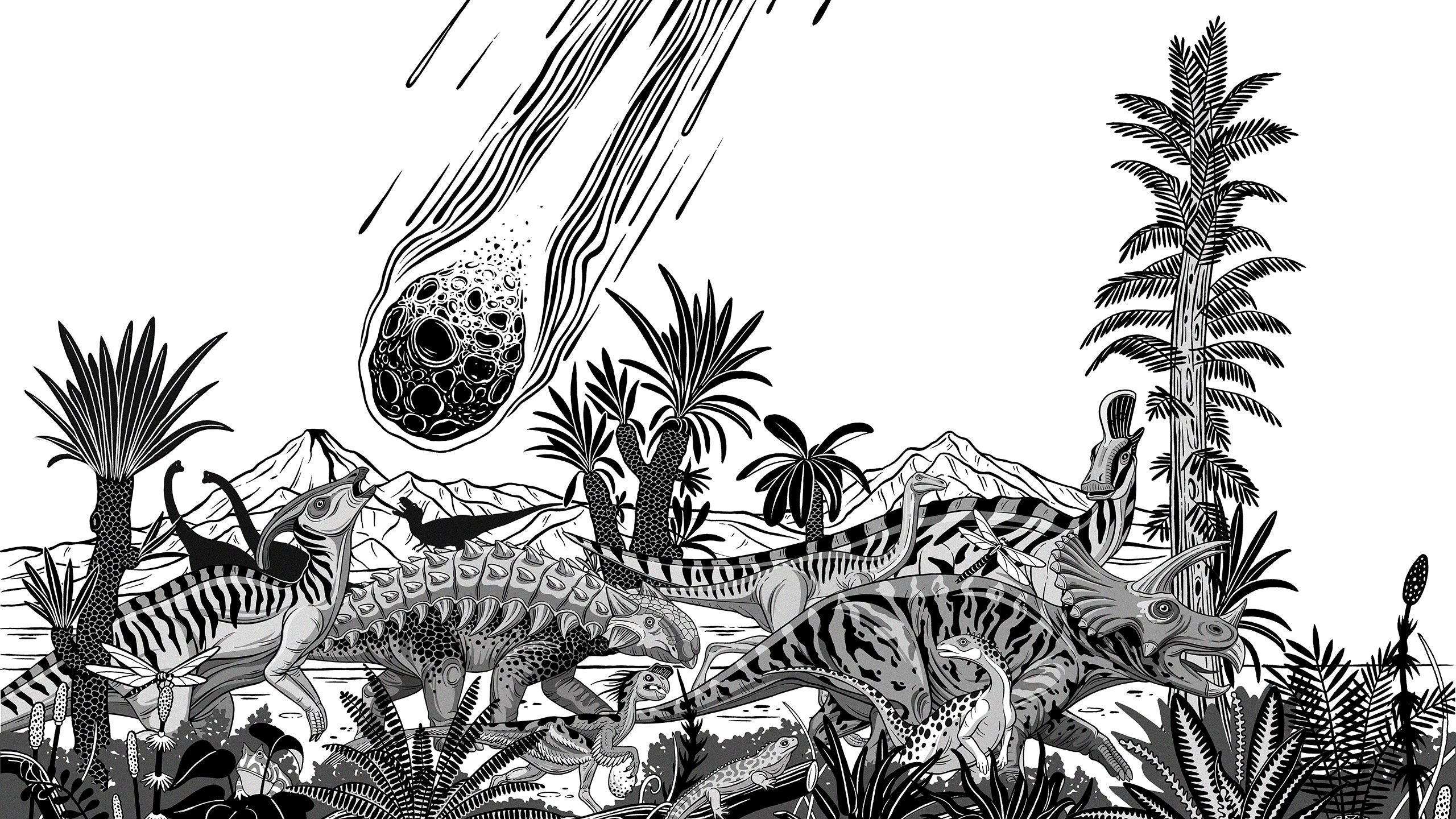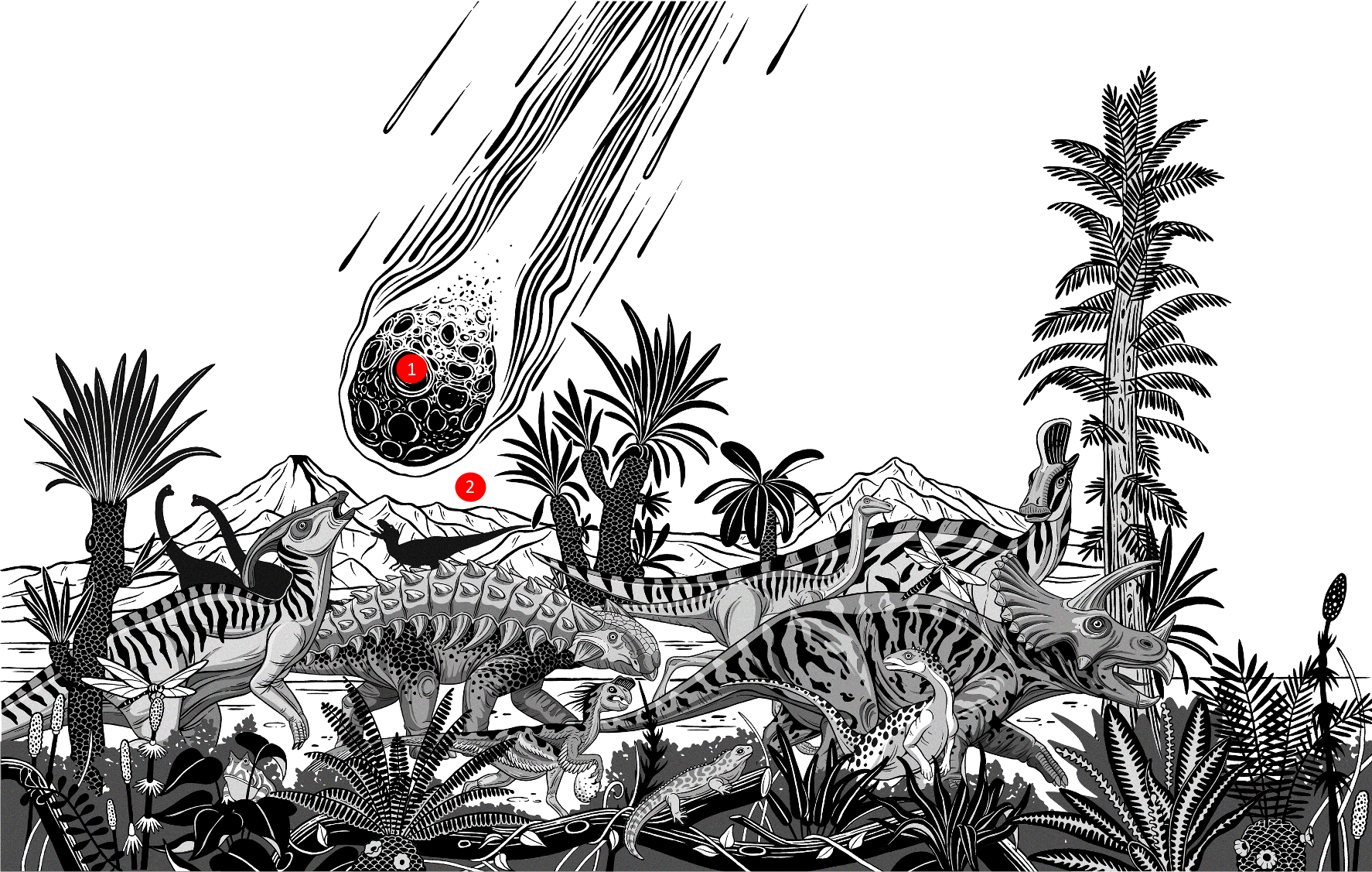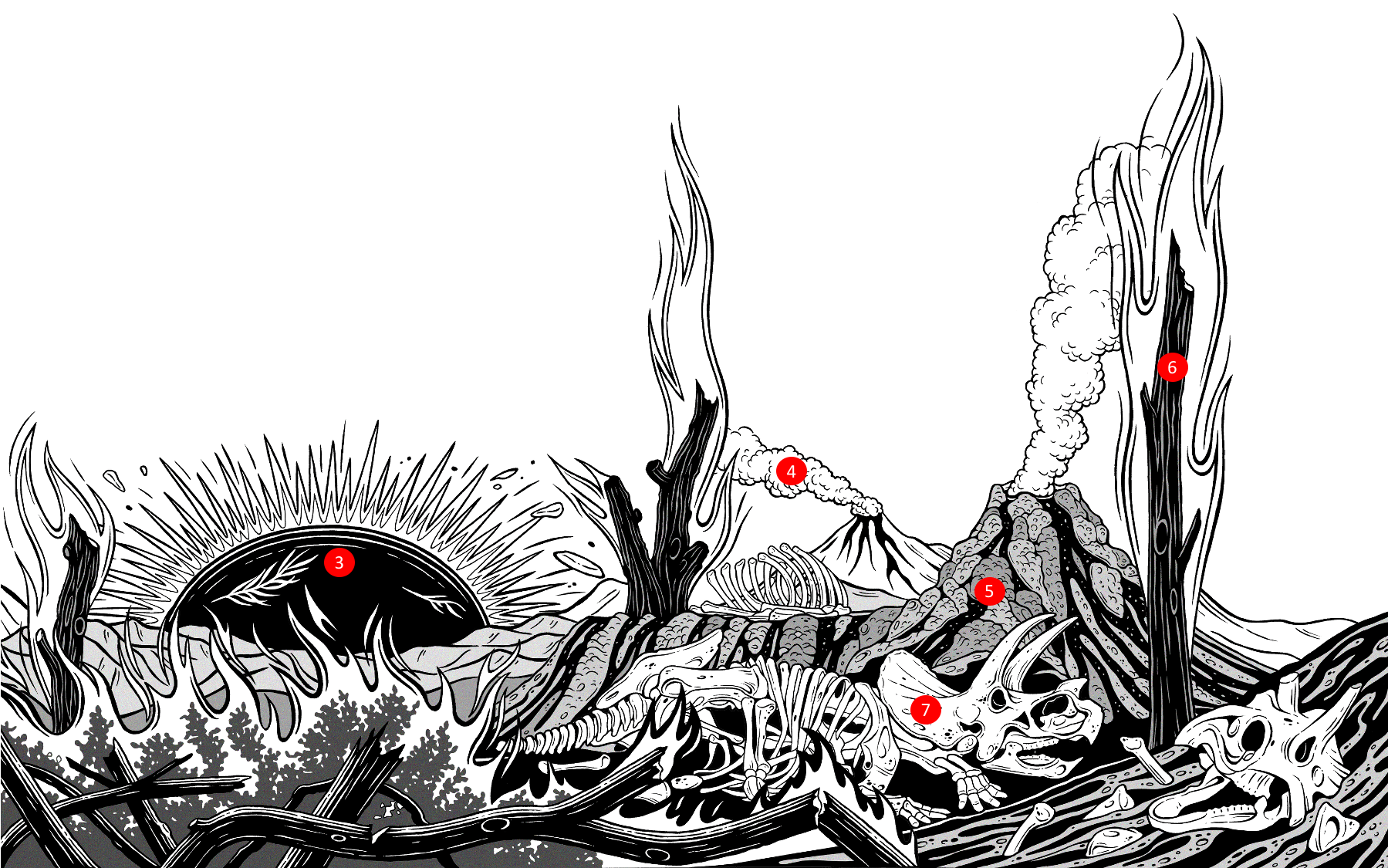Extinction day
New research is revealing exactly what happened the day the dinosaurs died.

For life on Earth, the day began like any other. Twenty-four hours later, dinosaurs – along with three-quarters of all other species – would be set on a path to extinction, smashed out of existence by an asteroid the size of a city travelling at speeds of up to 72,000km an hour. And, for the Earth itself, it was the end of the beginning.
“It was an unlucky day,” says Dr Matthew Genge (Geology 1989) in the Department of Earth Science and Engineering, in a masterpiece of understatement .
“The dinosaurs would barely have seen it coming, but the asteroid would have a catastrophic impact on the evolution of the planet.”
Given that these events occurred 66 million years ago, understanding the scale of the mayhem is a feat of the imagination – and a triumph of science.
The escaped piece of space rock, from the solar system’s asteroid belt, smashed into what is now the Gulf of Mexico at the worst possible angle. And, as a result of Imperial research, we now know – in unprecedented detail – what happened next.
It was an unlucky day
By raking over physical evidence extracted by drilling hundreds of metres into the ocean-covered crash site, and feeding on-the-ground measurements from the crater into a supercomputer, Imperial scientists within Earth Science and Engineering are painstakingly creating 3D simulations of the moment of impact and generation of a fast-moving dust cloud that circled the Earth in a few hours, initiating an impact winter that ended the reign of the dinosaurs.
After the initial flash, seismic waves would have travelled around the planet many times. Anything within about 1,000km would have been burned to a crisp, says Professor Gareth Collins (PhD Environment and Earth Science 2001) of the Department of Earth Science and Engineering, who has analysed numerical models of the impact run by colleague Dr Thomas Davison (MSci Earth Science and Engineering 2006, PhD 2011).
Dinosaurs living thousands of kilometres away from the impact would have broken bones after being smacked down by the hurricane-force winds.
A molten curtain of debris would have travelled around the world in a dust cloud, blocking out sunlight
Surrounding rock would have been liquified to form a pool of superheated melt 70km across and 3km deep. Further out, rock temporarily behaved like a fluid for about 10 minutes during crater formation.
As water rushed back into the crater, explosive steam jets would have shot into the sky. A molten curtain of debris – known as ejecta – would have catapulted above the Earth’s atmosphere and travelled around the world in a dust cloud, blocking out sunlight.
It would have felt like the end of the world. And while it wasn’t quite the end, the mystery of what happened on that day has fascinated scientists for decades.

When the asteroid hit: (1) The asteroid was the size of a city travelling at supersonic speeds of up to 72,000km an hour. Researchers estimate the asteroid hit with the equivalent power of 10 billion atomic bombs of the size used in World War II. It smashed into what is now the Gulf of Mexico at a 60-degree angle (the worst possible angle). Most of the asteroid, and a similar volume of rock that it struck, vaporised on impact – reaching temperatures of 5,000°C. Surrounding rock melted to form a pool of superheated melt 70km across and 3km deep. Further out, rock temporarily behaved like a fluid for about 10 minutes during crater formation. As water rushed back into the crater, explosive steam jets shot into the sky. A molten curtain of debris – known as ejecta –catapulted above the Earth’s atmosphere and travelled around the world in a dust cloud, blocking out sunlight. (2) In a matter of minutes, this rebound – briefly – formed a mountain on the scale of Mount Everest, but as the unstable mound collapsed back down, it created a flat, shallow crater, as well as the peak ring that stands about 500 metres above the crater floor.
When the asteroid hit: (1) The asteroid was the size of a city travelling at supersonic speeds of up to 72,000km an hour. Researchers estimate the asteroid hit with the equivalent power of 10 billion atomic bombs of the size used in World War II. It smashed into what is now the Gulf of Mexico at a 60-degree angle (the worst possible angle). Most of the asteroid, and a similar volume of rock that it struck, vaporised on impact – reaching temperatures of 5,000°C. Surrounding rock melted to form a pool of superheated melt 70km across and 3km deep. Further out, rock temporarily behaved like a fluid for about 10 minutes during crater formation. As water rushed back into the crater, explosive steam jets shot into the sky. A molten curtain of debris – known as ejecta –catapulted above the Earth’s atmosphere and travelled around the world in a dust cloud, blocking out sunlight. (2) In a matter of minutes, this rebound – briefly – formed a mountain on the scale of Mount Everest, but as the unstable mound collapsed back down, it created a flat, shallow crater, as well as the peak ring that stands about 500 metres above the crater floor.
Anything within about 1,000km would have been burned to a crisp
The asteroid theory was first suggested as the cause of the end of the dinosaurs back in 1980, but it wasn’t until 1991 that a 200km-wide crater was discovered beneath Mexico’s Yucatán peninsula and the Gulf of Mexico – it was named the Chicxulub crater, after a nearby town.
Four years ago, an international team, co-led by Imperial’s Professor Joanna Morgan in the Department of Earth Science and Engineering, began drilling deep into the crater site to extract samples of rock buried for millions of years – the first direct evidence to reveal accurate glimpses of the catastrophe.
Led by the results of a meticulous ocean-based seismic survey, a rig drilled through 20 metres of water and 600 metres of sediment before reaching the crater, eventually venturing nearly a mile deep .
It wasn’t the first drilling expedition, but this time scientists were more precise in choosing a site – in what is known as the peak ring – an inner ring of granite-like rock 500 metres high and 45km from the crater centre that formed shortly after impact during crater formation.
Out in a boat in the Gulf of Mexico, where they had been for three months, Morgan and her team watched as more than 300 cylindrical cores just 6.5cm wide and three metres long were hauled on board for examination in six makeshift labs.
“We’d pore over these pristine cores, which were encased in plastic to keep samples sterile,” says Morgan.
Geochemists and physicists were looking at physical properties, geologists at composition and mineralogy, and microbiologists for ancient signs of life. Scientists at that time were considering two different theories as to how the inner ring was formed, but, to Morgan’s delight, what they found proved beyond doubt what had happened.
Initially the impact gouged a hole 30km deep and 100km wide, ripping fault lines into the Earth’s mantle
The granite-like rock they extracted was from the mid-crust, 10km deep, which was highly fractured and shocked by the impact. It proved what’s known as the ‘dynamic collapse theory’, suggesting a deep rebound and outwards collapse. “It’s a very dramatic model,” says Morgan.
“Rocks moved tens of kilometres in the first ten minutes.” Initially the impact gouged a hole 30km deep and 100km wide, ripping fault lines into the Earth’s mantle and liberating billions of tonnes of chemicals.
“The Earth’s crust isn’t strong enough to keep the hole there – the walls collapse inwards and the bottom of the hole collapses – so that a huge volume of rock with a vast amount of energy shoots upwards,” says Collins.
In a matter of minutes this rebound – briefly – formed a mountain on the scale of Mount Everest, but as the unstable mound collapsed back down, it created a flat, shallow crater, as well as the peak ring that stands about 500 metres above the crater floor.

…When the asteroid hit: (3) Initially the impact gouged a hole 30km deep and 100km wide, ripping fault lines into the Earth’s mantle and liberating billions of tonnes of climatic-active gases. (4) At least 325 billion metric tonnes of sulphur were released by the impact. (5) Within minutes of the impact, fluidised basement rocks formed a ring of hills, which were rapidly covered by 40 metres of impact melt and breccia (sedimentary rocks). Within an hour, ocean waters flooded the deep crater, depositing another 90 metres of breccia. (6) The impact event ignited trees and plants that were thousands of miles away, and triggered a massive tsunami, as deep as the ocean and travelling at supersonic speeds, that reached as far inland as Illinois, 2,000km away. (7) In just one day, nearly 130 metres of material built up inside the crater. The dinosaurs, and 75 per cent of all life on Earth, were wiped out, but within 30,000 years of impact, Mexico’s Chicxulub crater fostered a thriving ecosystem – a much faster recovery than many sites around the world.
…When the asteroid hit: (3) Initially the impact gouged a hole 30km deep and 100km wide, ripping fault lines into the Earth’s mantle and liberating billions of tonnes of climatic-active gases. (4) At least 325 billion metric tonnes of sulphur were released by the impact. (5) Within minutes of the impact, fluidised basement rocks formed a ring of hills, which were rapidly covered by 40 metres of impact melt and breccia (sedimentary rocks). Within an hour, ocean waters flooded the deep crater, depositing another 90 metres of breccia. (6) The impact event ignited trees and plants that were thousands of miles away, and triggered a massive tsunami, as deep as the ocean and travelling at supersonic speeds, that reached as far inland as Illinois, 2,000km away. (7) In just one day, nearly 130 metres of material built up inside the crater. The dinosaurs, and 75 per cent of all life on Earth, were wiped out, but within 30,000 years of impact, Mexico’s Chicxulub crater fostered a thriving ecosystem – a much faster recovery than many sites around the world.
Evolution was altered forever
Imperial’s physicists fed the newly discovered evidence into a high-performance computer to model the impact and its aftermath in three dimensions.
When an asteroid strikes, the shape and geology of the crater depends on the angle of impact, and the team was able to deduce that the asteroid struck at around 60 degrees – the most damaging incline possible for life on Earth. But they were also able to calculate that, within 30,000 years of impact, Mexico’s Chicxulub crater fostered a thriving ecosystem – a much faster recovery than many sites around the world.
The team also fed information into the model that included the whereabouts of the centres of the crater and peak ring, and the location beneath the surface where dense rock from the Earth’s mantle has been uplifted. By aligning these points along an axis, the team could work out the direction of travel.
The team was able to deduce that the asteroid struck at around 60 degrees – the most damaging incline possible for life on Earth
“It was good to come out with such a clear vision of what it would have looked like,” says Davison.
“We think the asteroid travelled from the north-east. It was so big that the atmosphere wouldn’t have slowed it. The ring of peaks is offset to the south-west. ”
Simulations of a 60-degree strike from the north-east reproduced observations from the crater almost exactly. And it was this devastating angle that caused such large amounts of climatic-active gases, dust and burned carbon to be ejected at high velocity above the atmosphere and travel around the world, leading to cold and dark conditions for years after the impact.
For Earth, it was life-altering. The asteroid struck rocks that were rich in sulphur, carbon and organic matter, says Morgan. Unable to photosynthesise, forests, land and ocean plants died, and wildfires were ignited around the world. Life higher up in the food chain froze or starved to death. Evolution, says Morgan, was altered forever.
Expedition 364 was conducted by the European Consortium for Ocean Research Drilling (ECORD) as part of the International Ocean Discovery Program (IODP) and the International Continental Scientific Drilling Program (ICDP; Expedition 364).
Imperial is the magazine for the Imperial community. It delivers expert comment, insight and context from – and on – the College’s engineers, mathematicians, scientists, medics, coders and leaders, as well as stories about student life and alumni experiences.
This story was published originally in Imperial 49/Winter 2020–21.
